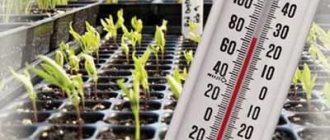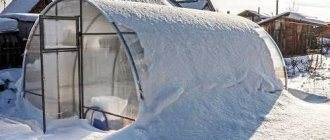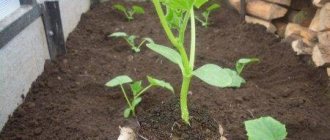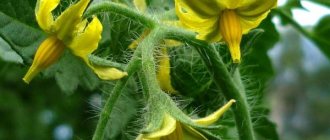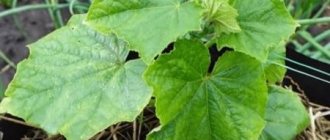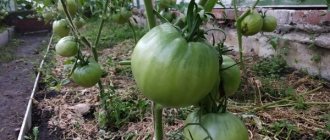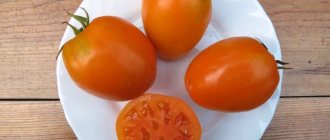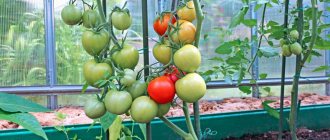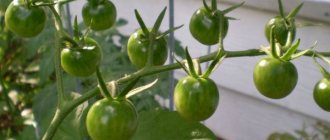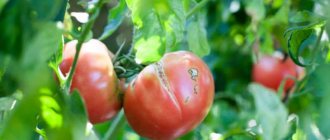The tomato is heat-loving; creating comfortable conditions when growing seedlings is easy, but after planting in open ground, difficulties arise. Tomato planting is carried out from mid-May to the end of June, when during the day the weather is more or less stable and warm, but at night sharp cold snaps can be observed. What temperature can a crop withstand in open ground, what consequences does a violation of the temperature regime entail, how to solve problems that arise during periods of sudden cold snap at night? Let's discuss.
How temperature affects tomatoes
The temperature for a tomato should be maintained in the range of 18-28° C. It affects the life of plants, from the moment of emergence to the end of fruiting:
- at 10° C, growth processes stop, the absorption of water and nutrients stops, and adventitious roots do not develop;
- 14° C – phosphorus and nitrogen are not absorbed;
- prolonged cold spell to 14-16° C – the pistil is stretched, the crop must be pollinated by hand;
- in summer, when the heat is 36° C, the pollen becomes sterile, fertilization does not occur;
- at 12°C, the production of lycopene, which turns tomatoes red, stops being produced; they remain yellow.
Temperature and humidity: finding balance
Speaking about the need to maintain a stable regime, it is important not to forget about air humidity. As with temperature, sudden changes are excluded. Tomatoes do not like high humidity, they begin to get sick and stop growing. Therefore, water only at the roots and between the rows, avoiding drops of moisture on the leaves, ovaries, and fruits. After irrigation, be sure to ventilate the shelters.
In film greenhouses, plantings are watered in the morning. If you do this in the evening, condensation will form by night. In polycarbonate shelters, afternoon watering is practiced (necessarily with warm, settled water).
The best humidity indicator for tomatoes is 60-70%. If the value exceeds 85-90%, then the plants’ pollen cakes, clumps, and is not separated from the stamens. The combination of low temperature and high humidity causes the ovaries to fall off and the occurrence of fungal diseases. Ripe fruits are watery, sour, tasteless.
At low humidity (25-30%), the process of pollen germination stops, it dries out, so the flowers are not pollinated. Fruit formation slows down and yields drop. It is important to maintain a balance of temperature and humidity, avoiding critical values and sudden changes.
Information about temperature conditions for tomatoes will help gardeners grow the crop correctly and create comfortable conditions for their favorite vegetable. Only in this case will the harvest please you!
Optimal temperature conditions after germination
After sowing the seeds, the seedling containers are covered with glass and placed in a warm place. They are ventilated daily and the humidity of the substrate is checked. At the same time, the gardener controls the emergence of seedlings. As soon as the first loop appears, the shelter is removed, the boxes or pots are transferred to a cool place, and 24-hour lighting is provided.
You can’t wait for friendly shoots. The strongest tomatoes hatch first, which, after transplanting into a greenhouse or garden, will produce the largest harvest. But if you keep them warm, they will grow into frail bushes.
Optimal temperature for tomato seedlings in the first week after germination:
- daytime – 14-17° C;
- night – 8-10° C.
Some sources recommend warmer contents - 16-18 and 12-14 ° C, respectively.
Reduced temperature relative to optimal indicators:
- ensures good root development, slowing down the growth of leaf apparatus;
- does not allow the hypocotyledonous knee to stretch;
- reduces the likelihood of blackleg disease;
- increases the resistance of seedlings to negative external influences;
- ensures rapid rooting after picking.
After 5-7 days, you should reduce the illumination to 12-14 hours, and grow tomatoes at a higher temperature. It should be different not only for different times of the day, but also depends on the weather outside. This needs some explanation:
- On a sunny day, the optimal temperature for tomatoes growing on a windowsill is 20-22° C.
- At night, photosynthesis does not occur, and the nutrients accumulated during daylight hours are actively processed. To prevent stretching, the temperature is lowered, but not so much that the seedlings could freeze or stop absorbing phosphorus. It should be at least 14, but not higher than 18 ° C.
- On a cloudy day, seedlings grown without lighting receive little ultraviolet radiation. The temperature is reduced to 17-19° C.
How to restore frozen tomatoes?
There are several ways:
- All the black part is cut off
- Diaper shelters are constructed above the planting
- Before this, smoking fires are made from tops and dry mullein along the perimeter of the beds. This smoke will warm the seedlings
- Feeding with humates and watering with urea is carried out
- The shelters are left for a week until the tomatoes recover.
Tomato seedlings
As you can see, there is no clear temperature at which tomatoes freeze. It directly depends on the stability of the seedlings and on whether you really hardened the tomatoes and prepared them for low temperatures and unfavorable climatic conditions.
Temperature after picking
The temperature for tomato seedlings immediately after picking should be reduced by several degrees (to 17-19° C). This will slightly slow down the growth of the above-ground part, giving the root time to recover from stress.
In the future, the temperature regime for tomato seedlings should be within 18-25° C. It is not always possible to adhere to the optimum of 20-22° C.
If tomatoes grow on a windowsill, the seedlings pressed against the glass may die in frost, even when the thermometer shows more than 20° C in the room. The air temperature inside the room is very different from that of frost-covered or simply very cold glass.
To prevent seedlings from freezing:
- move the tomatoes away from the window;
- protect the seedlings with a screen made of foil, a piece of plywood or polystyrene foam;
- From time to time change the side of the seedling box or rearrange the pot facing the glass.
The soil can also freeze, while the air is warmed up well. To increase the temperature, the tomatoes are placed on a stand - the containers stop touching the cold window sill, and a warm air layer appears between them.
When growing tomato seedlings, heat of 26° C and above is also dangerous. Seedlings should not be placed near radiators. But at home, where there is a battery under every window, this is problematic. You can protect plants by protecting them from heating devices with a foil screen and regularly ventilating the room. Dry tomatoes withstand cold less well.
When cool maintenance is needed
It is not always possible to grow tomatoes without allowing them to stretch. One way to curb growth is to lower the temperature. It’s easier to do this in a greenhouse - you can open the door briefly and quickly bring the air to an acceptable minimum.
In a city apartment, you need to ventilate the room often - create a draft, and cover the tomatoes with newspaper. The night drop is arranged by placing the seedlings on the floor near the slightly open balcony door - there the temperature is lowest.
Saving tomatoes from frost
The weather in Russian regions is unpredictable, and although summer residents watch what the expected temperature is and closely monitor forecasts, they must be prepared for various “surprises.” Even in June, a temperature at which tomato seedlings freeze is possible, and sudden changes (cold at night, hot during the day) are typical for many areas.
To prevent tomatoes (in open ground) from getting caught in the cold, small fires are lit in the area. The smoke from them fumigates and warms the plants, so light frosts are not dangerous even for young seedlings.
On a note! When making fires, follow safety rules and be sure to control the combustion process.
In greenhouses, special heating tablets are often used, which are set on fire at night. The plantings are also additionally covered with lutrasil or other non-woven material. Small plants are covered from above; for adult tomatoes, a frame is first built. The fabric is removed during the day, otherwise it is easy to cause overheating of the plants.
Instead of non-woven material, it is allowed to use bubble wrap, old blankets or bedspreads. Water bottles are suitable for warming the air in greenhouses. Filled plastic containers with a volume of 1.5-2 liters are placed in the beds around the greenhouse. During the day, the water will heat up, and at night, as it cools, it will give off heat. Instead of bottles, you can place small barrels or tanks in shelters.
For small plants (for example, immediately after planting seedlings) five-liter plastic eggplants are often used in the garden bed and in the greenhouse. The neck is cut off, and the container is placed on the bush so that it is inside the “greenhouse”. The bottles are removed during the day, otherwise the plants will overheat in the sun.
If it happens that tomato seedlings are frozen, then act immediately:
- cover plantings from the sun's rays;
- carefully remove the affected areas;
- add nitrogen-containing compounds (potassium humate, infusion of chicken manure);
- the surviving plants are treated with Epin, the Healthy Garden preparation.
Even if it is not possible to revive all the seedlings, some of the tomatoes will be saved. Tomatoes quickly “move away” from such troubles and produce new roots.
Temperature when hardening tomatoes
In order for the bushes to quickly take root, adapt to the garden, immediately begin to grow, and get sick less often, they need to be hardened off before replanting. This is especially important when growing in open ground.
Planting tomatoes without adaptation to external conditions is risky - they may die.
The operation takes at least 7 days, but it is better to allocate 10-14 days for it. Hardening should occur smoothly.
Choose a clear day with a temperature of at least 15° C, leave the seedlings on the balcony or street for 20 minutes. The time is gradually increased, and the tomatoes are taken out into the fresh air, regardless of the weather.
For the last 2-3 days, the seedlings should spend the night outside. A minimum temperature of 10° C is acceptable. If a cold snap is expected and the thermometer drops below, the tomatoes are covered with non-woven material and old clothes, but are not brought into the house.
Seedlings undergoing hardening must be watered!
Heat protection
Tomatoes will be able to withstand short-term heat of up to 40-42 °C without significant negative consequences for growth and development, however, if such conditions persist for more than 1-2 days, it will not be possible to save tomato seedlings from death.
Critical temperatures (up to 45 °C) are often observed in summer in closed greenhouses starting in the early morning.
The best ways to protect greenhouse seedlings and plants planted in open ground from the effects of heat are ventilation, creating shade and watering:
- when the temperature rises to the maximum permissible limits in the greenhouse, open all windows and doors - such ventilation reduces the indicators by 8-10 points;
- in the beds, with the help of a light covering material, they create shade and protection from the burning rays of the sun;
- Additionally, the seedlings are watered abundantly, which allows the temperature to be reduced by approximately 9 points.
On hot days, some gardeners spray the walls of the greenhouse with a solution of chalk (2 kg) and milk (300-400 ml) based on water (10 l).
Minimum temperature in open ground
The seedlings are moved to a permanent place when the ground outside warms up:
- for greenhouses – up to 10° C;
- when grown in open ground - up to 15° C.
Soil temperature can be measured with the cheapest probe thermometer used in cooking. As a last resort, wait until the threat of night frosts has passed and the air outside does not fall below 15 degrees for several days:
- for open ground - at night;
- when planting in greenhouses - during the day.
The minimum temperature for planted seedlings is plus 3° C. They can withstand it for a short time, only a few hours. So in regions with problematic climates, it is recommended to always have a covering material on hand - film, spandbond, agrofibre. And carefully monitor the weather forecast.
Expert website Pomidoroff.ru
Maria Nikolaevna
Experienced vegetable grower, 40 years of experience. Graduated from Michurinsk State Agrarian University (MICHGAU)
Ask a Question
The lowest temperature that well-rooted and renewed growth tomatoes can withstand for several hours is minus 2° C. Siberian varieties are more resistant and can withstand -4° C.
Prolonged cooling down to 10°C stops the growth of tomatoes. The roots stop performing their assigned functions - supplying water to the above-ground part and absorbing nutrients.
If the weather surprises only at night, or turns bad for several days, this may slightly delay the ripening of the fruit. The consequences are minimized by treatment with epin or zircon, and after warming - by unscheduled fertilizing with a complete mineral complex.
Precautionary measures
To protect tomatoes from sudden day and night temperature changes you need to:
- To plant seedlings, choose a southern, sunny, windless area;
- The soil should be loose, not waterlogged, so that the roots do not freeze;
- Mulch the tree trunk area to create an air insulating cushion;
- Until the weather calms down, you can create a small, spacious greenhouse made of polyethylene so that the leaves do not come into contact with it, or cover it with agrofibre;
- Water during planting and in the following days only with warm, sun-warmed, settled water, exclusively at the root;
- Watering is done at the root.
If there is a threat of night frosts:
- Young bushes can be buried in soil overnight;
- Place containers of water around the perimeter;
- Light a fire, creating a smoke screen;
- Cover the top with any covering material.
If precautionary measures were not taken in time, and individual parts froze, then a number of resuscitation measures will help the bush recover:
- Water the plant at the root with warm water;
- Trim burned leaves;
- If the trunk is frozen, cut it off at the root (a new shoot will grow from the lower bud);
- Cover the top with agrofibre, protecting the plant from additional sunburn;
- Feed the plant at the root with nitrogen fertilizer (urea, saltpeter), bird droppings, humate;
- Treat by spraying the leaves with Epin, Zircon, Tsitovit;
- During the first week, do not remove the agrofibre or polyethylene, only occasionally opening it for hardening.
With proper further care, you can get a good harvest from such bushes, only two weeks later than usual.
What determines the quality of the crop?
Watering. Until the seedlings have taken root, you should refrain from watering. The first watering should be done approximately 10 days after planting. The water should have an average temperature of +20-23 degrees. After flowering begins, watering should be increased from 5 liters per 1 sq. meter to 10 liters.
Ventilation. Two hours after watering and at other times, the greenhouse should be ventilated by opening the windows or door and lifting the film. This should not be neglected, because temperature conditions are very important, especially during flowering.
Garter. Already on the third day after planting, you need to start tying. The procedure is carried out so that the stem of the plant does not break under its own weight, and the fruits do not rot.
Stepsonning. Stepchildren are the side shoots of a plant that grow not on the stem, but from the axils of the leaves. In this way, they branch the bush, which leads to shading, the spread of diseases and a reduction in the ripening period of the fruit.
Important! The pinching procedure is usually carried out in the morning to dry the wound. Top dressing
Without fertilizing, it is unlikely that you will be able to get a really large and juicy harvest. The first feeding is applied 10-15 days after planting, the second - after another 10 days. Ultimately, the procedure needs to be done four times during the season.
Feeding. Without fertilizing, it is unlikely that you will be able to get a really large and juicy harvest. The first feeding is applied 10-15 days after planting, the second - after another 10 days. Ultimately, the procedure must be done four times during the season.
Minimum temperature threshold that tomatoes can withstand
The minimum temperature that tomatoes can withstand in greenhouse conditions depends on the plant variety. The average value fluctuates between 5...7 ºС. Undoubtedly, there are special frost-resistant varieties, mainly hybrids, that can withstand lower temperatures, but for a very short time. The negative impact of low temperatures has a detrimental effect on the growth and fruiting of tomatoes, so the constant temperature in the greenhouse should be higher. Before planting tomatoes in greenhouse soil, seedlings must be briefly exposed outside in the sun to harden the tender indoor tomatoes. This procedure will increase the resistance of plants.
Conditions for planting and growing seedlings in a greenhouse
Growing tomatoes does not require much effort from gardeners, which is why they are so widespread. Even in deserts, where the soil is very poor, local residents do everything possible to get the coveted harvest.
Still, it takes a little effort to create favorable conditions for a good harvest. What should you do before boarding?
Tomatoes in a greenhouse
Prepare the greenhouse
As you know, it is in the greenhouse that the harvest is several times larger. But it is possible to achieve a harvest and prevent diseases only if the greenhouse is properly prepared.
Since tomatoes are planted in early May, the seedlings should easily tolerate fairly cold nights. Therefore, it is necessary to cover the greenhouse with a double layer of film, if it is not made of glass or polycarbonate.
It is necessary to leave a so-called air cushion between the layers of polyethylene, which increases the temperature inside the greenhouse and increases the service life of the inner layer. Be sure to make vents for ventilation.
Important! It is impossible to plant tomatoes in the same greenhouse for two years or more; infections, bacteria and pests remain in the soil, which can destroy new seedlings
Prepare the ground
Before planting a new crop, you need to start preparing the soil 10-14 days in advance. You should get rid of last year's soil by 10-15 centimeters, and treat the rest with the well-known copper sulfate in the proportion of 1 tbsp. l per 10 liters of water. Loosen the finished beds, get rid of numerous weeds and fertilize with humus.
The more fertile the soil, the less humus will be needed. And, accordingly, vice versa.
Prepare the seedlings
Properly prepared seedlings play a very important role in the quality of the harvest. You will need boxes or boxes about 10 centimeters high. Inside is placed either a purchased soil mixture or one prepared from peat, humus and turf soil in equal quantities. The soil must be moistened.
After the soil has been compacted, they begin to form furrows (they are usually made 1-2 centimeters deep). Having placed the seeds and covered them with the prepared mixture, the container should be placed in a bright place.
Important! After 5 days it should be covered with a film cap. This way the seedlings should sprout faster
About a week or a little later after germination, two true leaves should appear. When this happened, it was time to dive. This is the transplantation of plants from one container to another, more spacious one. This is a mandatory stage: the root system has already become stronger and requires more space.
Each plant is removed along with the soil (usually using a toothpick) and moved into a spacious pot.
To prevent the seedlings from stretching out, the gardener must observe the temperature regime and monitor the lighting, changing the side facing the light every day.
Typically, seedlings are kept in pots for no more than 50 days, during which time their height reaches about 30 centimeters. When there are 10 days left before planting tomatoes directly in the greenhouse, they should be regularly hardened off on the balcony or with the window open all night.
Development of tomatoes under cover
Don’t think that tomatoes have a very sweet life in a greenhouse. It’s good if the owners are constantly nearby and can open and close the windows and doors several times a day. A gardener can come to a summer cottage 1-2 times a week, during which time the temperature during the day sometimes reaches critically high values, or at night the bushes can freeze when the window is open. Cover the plantings with non-woven material; it will slightly protect the tomatoes from temperature changes.
The most dangerous transitions from heat to cold occur under a film with a small greenhouse volume. It’s better to spend money once, make a large glassed-in building, and grow excellent tomato crops in it for several years, than to change the covering every year, and rush to the dacha to save the plantings every time there is an unfavorable weather forecast. A commercial vegetable grower can install automatic windows in the greenhouse, which themselves open or close at specified parameters. Set them to low +18⁰ and high +25⁰, and your pets will always have the optimal air temperature.
The tomato bush itself can hardly live at temperatures up to +40⁰, but as a result you will only get greens and yellow flowers. They can be picked and placed in a vase, since pollen does not ripen above +35⁰, and you still won’t get fruit. If, upon arriving at the dacha, you see that the air in the greenhouse is too warm, urgently open the windows and doors and create a draft. This procedure, supplemented by abundant watering, will help cool the plants by about 9⁰.
Tomatoes are not afraid of drafts; they even benefit when a breeze dries and refreshes the air. In strong humidity, pollen cannot detach from the stamen and fertilize the pistil. It is also necessary to open the windows in the greenhouse so that bees can enter the room and pollinate the tomatoes.
The right temperature is the key to a good harvest
In order to grow tomatoes properly, many conditions must be met. It is important to ensure that the seedlings have enough light, organize proper watering, and properly fertilize. All these factors are interconnected and together ensure good development and growth of tomatoes.
Maintaining the right temperature for tomato growth is very important. If we are talking about open ground, then the plant develops well at temperatures from 22C° to no more than 24C°. The temperature in the greenhouse for tomatoes should not exceed 31C°. With this amount of heat, growth is more intense. When it rises to 33C°, the growth process becomes slower, and when the thermometer reaches 35C°, growth stops.
But first, any gardener needs to decide on the choice of variety and decide where the plants will be planted. If you are going to grow tomatoes in an open area, then you need to choose low-growing varieties with a strong root system and early ripening. And if you decide to plant plants in a greenhouse, then tall varieties with a later ripening period are suitable for you.
Air temperature requirements
In order for seedlings to grow viable, certain temperature conditions are created for them corresponding to the stage of development.
When planting seeds
The seeds are germinated before sowing. This procedure increases their germination rate. Planting material is germinated at temperatures from +25 to +30 °C. At lower values, seeds will germinate much more slowly.
To ensure optimal temperature conditions, germinated seeds are placed on a radiator. It is important to promptly moisten the fabric in which the planting material is wrapped.
When the seeds are sown in the ground, the temperature in the room is maintained from +24 to +26 °C.
How to ensure the required conditions:
- Cover the box with the seeds with film.
- Place foam under the bottom of the box.
- Windows should provide maximum light, so boxes with crops should be placed on the south side.
After germination
When seedlings appear in the seedling boxes, the temperature is adjusted in such a way as to grow the strongest seedlings.
Temperature conditions after germination:
- First week. Maintaining low temperatures during the first week after germination helps prevent sprouts from stretching. Recommended temperatures:
- daytime – from +13 to +18 °C;
- night – from +11 to +14 °C.
- Second week. The temperature is gradually increased. Recommended values:
- on clear days – from +20 to +23 °C;
- in cloudy weather – from +18 to +20 °C;
- night – from +17 to +19 °C.
Many experienced gardeners adhere to other rules; they believe that temperatures should be lower:
- in cloudy weather – from +16 to +19 °C;
- at night – from +10 to +13°C.
Extreme caution must be taken as the temperature drops. Even a loss of 2-3 degrees Celsius can negatively affect seedlings.
A slight drop in temperature can provoke:
- weakening of the root system;
- developmental delay, which will negatively affect productivity.
Overheating has an equally detrimental effect on the development of seedlings. The sprouts stretch out, their stems become thin and weak.
At this stage, daylight hours should be at least 10 hours. If there is not enough light, turn on the lamps. The soil is moistened with a spray bottle, avoiding stagnation of water.
After the pick
If the seeds were sown in a common container, the seedlings have to be picked - planted in separate 0.5 liter glasses.
Recommended temperatures after picking:
- on clear days – from +20 to +23 °C;
- in cloudy weather – from +16 to +18 °C;
- night – from +12 to +15 °C.

